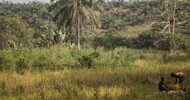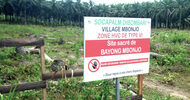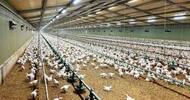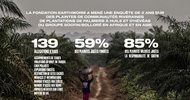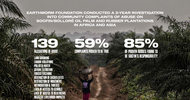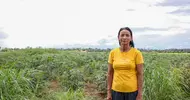Financial Times | May 6 2009
David Stevenson
I’ve just been sent a rather interesting follow up article to my own note on Canadian farm land.
It’s from Andrew Shirley, head of property research, at Knight Frank and featured in their regular Wealth Report. Its a really strong round up of global trends and I think reinforces my central argument that land is a good idea even in a recession but only if you’re willing to look globally
Over to Andrew:
David Stevenson
I’ve just been sent a rather interesting follow up article to my own note on Canadian farm land.
It’s from Andrew Shirley, head of property research, at Knight Frank and featured in their regular Wealth Report. Its a really strong round up of global trends and I think reinforces my central argument that land is a good idea even in a recession but only if you’re willing to look globally
Over to Andrew:
“Agricultural land was the darling of the property market for much of last year. The world seemed in the grip of a massive land rush as new farmland funds touted for business and governments from cash-rich, but food-poor, nations scrambled to secure productive farmland to feed their populations.
One of the key drivers was a surge in soft commodity prices. World cereal stocks were dwindling and the price of “green” biofuels, produced from crops like maize (corn), sugar cane and oilseed rape (canola), escalated rapidly in tandem with burgeoning oil prices. Investors, looking to take advantage of this bull run, piled into anything to do with farming; from trading grain on the futures markets to buying stakes in agricultural companies and, of course, acquiring the ultimate agricultural asset – the land from which all our food is ultimately derived. No corner of the world, however unstable, seemed to escape attention.
In some areas that were fundamentally undervalued this helped push prices to more realistic levels, but in others it created a bubble that has now started to deflate as recession forces down commodity prices and potential investors struggle to access credit. In some cases it has burst spectacularly.
The Ukraine falls into the latter category. A country with countless under-utilised hectares of fertile black Chernozn soils, it seemed ripe for investment. In their eagerness, many investors overlooked the issue of land tenure – in the Ukraine there is no legal framework that allows private ownership of land, you can only buy the right to rent it. A situation less than desirable in a mature and transparent democracy, rather more risky in a country with an embryonic political system battling to survive.
Long-term lease agreements from two to 20 years were being sold to eager investors for up to $1,000/ha at the beginning of 2008. Now, following an IMF bailout of the Ukraine and a total loss of investor confidence, they are worth only $250/ha, according to Brown & Co, a company which advises on land deals in parts of Eastern Europe and Russia.
Land values in surrounding areas with similar soils, but more stable environments have fared better. In Russia, the primary land market – those small blocks of land distributed to individuals following the fall of communism - has remained stable at about $300/ha. Large consolidated blocks of more interest to investors have fallen by about 20% to $800/ha.
In countries where demand is supported by indigenous farm businesses as well as external investors, there has been less of a slowdown. Within the EU, agricultural subsidy payments also help to put a floor in the market. In Poland, for example, arable land values have undoubtedly fallen since peaking last summer, but still ended 2008 10% higher at about 20,000 Zloty (€4,800/ha) than they were at the beginning of the year.
Newer members of the EU like Bulgaria and Romania are tempting for investors because they offer the prospect of an increase in capital values as land prices, bolstered by subsidies, improved national stability and unfettered access to EU markets, gradually catch up with prices in countries like France and the UK.
Investing is not without risk, however. Agricultural infrastructure lags behind western Europe and land tenure, while legally binding, is less transparent. Much of the land remains in small post-communist parcels with consolidated blocks attracting a premium price. In Romania, values stayed at about €3,500/ha during 2008, but are likely to weaken as potential investors struggle to access funds this year, says Brown & Co. Reports from Bulgaria suggest values have already weakened by about 30% to €2,250/ha.
When looking at potential investments around the world, the significant shifts in exchange rates make it important not just to look at changes in home-currency values. English farmland, despite falling in value in the final quarter of 2008, still increased by 16% overall during the year to almost £12,000/ha, according to the Knight Frank Farmland Index. However, Sterling’s slide against the Dollar and Euro, meant land at the beginning of this year was actually 16% cheaper for US buyers and 11% down for those from the Eurozone.
Brazil is another country where currency fluctuations are working in the favour of outside investors. One US dollar bought only 1.5 of the country’s Reais last august, now it will buy about 2.3. Despite this, the credit crunch means investor activity has virtually ground to a halt since July last year, says specialist investment adviser Agrifrontiers.
In Brazilian Reais, average values rose by 8% last year to 4,334 Reais/ha ($1876/ha), according to the AgraFNP land price survey. But land used to grow sugarcane has been badly hit by falling ethanol values, which have been dragged down by the massive slump in crude oil prices. Land in some cane-growing areas is reported to have fallen by up to 50%.
Determining the value of land used for soy and cereal production, which has risen rapidly in the past few years and can now cost up to 20,000 Reais, is difficult because few deals are being done, but Agrifrontiers says lower returns from maize and soya crops will hit farm profitability and prices will weaken.
In Argentina, Brown & Co reckons productive farmland, which has been selling for $7000-$8000/ha around Buenos Aires, is now overvalued by 30%. Once vendors reduce their expectations investors should consider buying again.
One of the biggest attractions of South America is the availability of vast swathes of cheap, undeveloped land that can be converted into much more valuable cropping or pasture land and sold on for big profits. In Brazil it is still possible to buy 100,000ha of undeveloped land in a single block. Prices vary depending on accessibility and environmental restrictions, but can be low as the equivalent of $200/ha in both Brazil and Argentina.
US land values are very much linked to farm profitably and have been rising strongly. The United States Department of Agriculture estimates farm incomes reached almost $90bn last year, 42% above the 10-year average. Much of the rise was fuelled by a rash of new maize-hungry bio-ethanol refineries. Farmland values in the country’s mid-western breadbasket states rose rapidly as result, with prices in Iowa increasing 14% to average $11,000/ha. Further rises now seem unlikely with falling ethanol prices threatening the viability of many refineries.
In New Zealand, dairy produce accounts for 27% of the country’s exports. Milk prices have fallen 35% from last year’s peak as global prices weaken and there is already some evidence that this is feeding through into land values, which are strongly linked to farm profitability and have been increasing. The most recent official figures show average farmland values rose 13% in the first half of the year to NZ$16,683/ha ($9642/ha).
While the credit crunch has affected demand for land in most parts of the world, Australia and Canada actually seem to be benefiting. The combination of relatively cheap land in a low-risk political and economic environment is attracting investors who might otherwise have considered South America or Eastern Europe.
In the Canadian prairie provinces, average values rose 10% in 2008 to C$2105/ha ($1722/ha) and there is no sign of prices falling back yet, says fund manager Agcapita. Low cereal yields and some ownership restrictions, especially in Saskatchewan, explain why values seem so cheap.
Australian cattle ranches the size of small countries attract most media attention when they are sold – the Packer family was reportedly looking for the equivalent of almost £200m for its two million hectare Consolidated Pastoral business earlier this year – but real estate adviser Philip Jarvis Associates says most international investors are looking for productive cereal land. Last year average values rose 5-10% to about AU$4950/ha ($3325/ha).
For the far-sighted investor, especially one spending dollars, an agricultural downturn could be the time to consider buying farmland. Most commodity analysts believe the current situation is a dip in a much longer upwards trend, which is being driven by an increasing world population, changing food consumption habits, the loss of prime farmland to development and degradation, and a slowdown in agricultural productivity.
Deciding where to invest will very much depend on your aversion to risk - some of the areas with the highest potential returns also offer the biggest challenges. Increasingly erratic climate patterns can generate huge swings between profit and loss even in temperate areas, while the factors that analysts claim will boost commodity prices in the future, such as global population growth, will also ensure the politics of food production become increasingly contentious.
Nations with plenty of money but limited agricultural resources have already been accused of neo-colonialism as they try to secure land in some of the world’s poorest countries like the Sudan and Cambodia. Rapidly escalating food prices prompted riots across the developing world last year and foreign ownership of land may not sit well with poor populations struggling to feed themselves.



